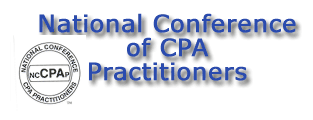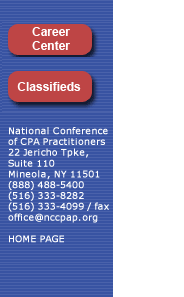

| |
|
|
|
|
|
|
|
|
|
|
|
|
|

July 2005
MEMBERS’ CORNER
BY STANLEY TEPPER, CPA, MBA
Connecticut Estate Tax – On June 7, 2005 the Connecticut Legislature gave final approval to a bill, which restored an Estate Tax. The Plan taxes the transfers of estates valued at $2 million or more beginning at about 5 percent and topping out at about 16 percent. Including Connecticut there are about 18 states that have kept their own version of an estate tax.
Elder Law – Jeanne Corea a member at the Estate Planning and Elder Law Firm of Bongiorno & Corea, PLLC with an office located in Mineola lectured our chapter in May, 2005 concerning Elder Law.
NURSING HOME MEDICAID ELIGIBILITY
To be eligible for nursing home Medicaid, a person may not have more than $4,000 of assets, term life insurance and a prepaid irrevocable burial fund in any amount. As for income, the person is permitted to retain $50.00 of monthly income and a monthly stipend to maintain their supplemental health insurance.
If there is a community spouse, that spouse is permitted to retain a house of any value and $95,100 of assets. Any assets over and above this amount will render the institutionalized spouse ineligible for nursing home Medicaid benefits, unless the community spouse has executed and submitted a “spousal refusal” simultaneously with the Medicaid application for nursing home benefits.
As for income requirements for the community spouse, he or she is permitted to keep the greater of his or her own income of $2,378 per month. If the community spouse’s income falls below $2,378, he or she can take additional income from the institutionalized spouse to bring the income allowance up to $2,378 per month.
HOME CARE OR COMMUNITY BASED MEDICAID
Income allowance for applicant $667 + 20 month
Resource allowance $4,000 and Irrevocable Prepaid Burial Fund
No penalty periods imposed for transfers made.
Jeanne can be contacted at (516) 741-3720.
Annual Filings No Longer Required for IRC 125 Plans (Katz & Company Seminar (631) 435-2700)
What occurs if my client’s plan is NOT amended and restated?
Disqualification
“In order for a plan to be qualified, both its terms and its operations must meet the statutory requirements.”
Form defects – A form defect is plan language that does not meet the qualification requirements of IRC section 401(a). The most frequently litigated form defect is the failure to timely amend a plan to comply with changes in the law.
Numerous cases have upheld the IRS’s disqualification of a plan even though it was administered in conformity with the law, solely on the ground that the written instrument had not been amended to comply with the law.
QTIP Trusts – The Wealth Bloomberg Magazine contained this advanced planning article on the subject of QTIPS.
Estate Plans Don’t Work Out As Well in real life as they do on paper – and often involve QTIP trusts. This tax deferral vehicle links two sets of beneficiaries who have inherently conflicting interests, and who often dislike each other as well. Unhappy QTIP trust beneficiaries and their advisers usually take it for granted that they can do nothing to change their lot. But you can undo a QTIP trust. True, tax and legal hurdles make it expensive, but for some families – whether they’re eager to go their separate ways or they simply have a pressing need for a chunk of cash – the price is worth paying.
The QTIP trust – less well known as the qualified terminable interest property trust – was created in 1981 to solve an unintended problem resulting from the then-new unlimited marital estate tax deduction. Tax rules didn’t allow a decedent’s estate to take a marital deduction for assets in which he left his spouse only a lifetime interest. To get the unlimited martial deduction, the decedent would have to leave all his assets outright to the surviving spouse, who might not ultimately leave them to the decedent’s intended long-term beneficiaries.
The QTIP lets a taxpayer control the ultimate disposition of his or her assets without having to give up an unlimited marital deduction. It provides lifetime income to a surviving spouse; upon his or her death, the principal then goes to remainder beneficiaries, typically the decedent’s children. To qualify for the unlimited martial deduction, the trust must pay all its fiduciary accounting income to the surviving spouse at least annually. The trustees can invade the principal on behalf of the surviving spouse, subject to the terms of the trust, but trust assets can’t be assigned to anyone else during his or her lifetime. When the surviving spouse dies, the QTIP’s value is included in that spouse’s taxable estate.
Q. How many People File Amended Returns?
A. The IRS says it expects to receive about 3.6 million amended returns on Form 1040X this year. Some very prominent Americans have filed amended returns in the past.
For example, Sen. John Kerry of Massachusetts said last year that he had filed an amended tax return for 2003 to correct a mistake in reporting the sale of his interest in a painting. His tax preparer used the wrong capital-gains rate, and Sen. Kerry had to pay more in tax. (The top long-term capital gains tax rate is 28% on the sale of a piece of art – much higher than the top rate of 15% on long-term gains from sales of stock, bonds and other securities.)
Heart Attacks –
Warning Signs for Men:
- Pressure, fullness, tightness/squeezing pain in your chest. Many people expect this pain to be sharp, stabbing sensation often portrayed in the movies, but in reality the symptoms are subtle. This causes many people to mistakenly delay medical treatment – often with fatal results
- Pain or discomfort in the arms, back, neck, jaw or stomach
- Shortness of breath, especially when you have not been exercising previously
- Lightheadedness, fainting, sweating/cold sweats and/or nausea
Warning Signs for Women :
More women die of heart attacks each year than men. Science, as yet, does not fully understand why the warning signs are different.
- Nausea, vomiting
- Sweating, lightheadedness
- Breathlessness
- Neck, shoulder or abdominal discomfort
Small Business Owner’s Guide
Newsday wrote that if you’re a small business owner considering implementing a retirement plan, why not let the IRS send you something for a change?
A new CD, “IRA Resource Guide for Small Business Owners,” will guide you in the steps you need to implement an IRA retirement plan for you and your employees. It has information on all IRA-based plans available to employers, including Roth IRAs and payroll-deduction IRAs.
It will advise you how to make contributions to the plan, what types of investments you can make and the ins and outs of taking distributions. Many small business owners prefer IRAs to 401(k)s because they’re easier to set up and have lower administration costs.
To get a free copy of the CD, call the IRS at 800-829-3676; ask for Publication 4395. You can also access an online version at www.irs.gov.
Best of all, this is one gift you won’t have to report on your 2005 tax return.
Qualified Personal Residence Trust (QPRT) –
The Certilman, Balin Estate Tax Newsletter edited by Stephen Silverberg & Lisa Hunter contained this article about QPRT’s. (516) 296-7111.
The applicable exclusion is the amount you can leave to your heirs without paying an estate tax. For decedents dying in calendar year 2005 the amount is $1.5 million. This amount increases over the next few years and then drops to $1 million for those dying in 2011 after the federal estate tax repeal in 2010 only. Congress will no doubt change this in years to come.
During an individual’s life he or she can make taxable gifts of up to $1 million. The amount of the $1 million gift tax exclusion used during life is then subtracted from the applicable exclusion amount available at death. To leverage the amount that passes to heirs free of estate taxes, clients often use a qualified personal residence trust (QPRT).
A QPRT allows you to transfer ownership of a residence into a trust while retaining the right to live in the house for a specific period of time. At the end of the period, the trust owns the property for the benefit of the remaindermen, typically your children.
The value of the gift to the remainder beneficiaries at the time of the transfer of the residence to the QPRT is less than the current value of the property and depends upon the term of years reserved by you, the grantor. Once you survive the term of years and the remainder beneficiaries own the property interest, the full value of the residence as of the date of your death escapes estate taxes.
Here are some tips to help you create a successful QPRT:
- Don’t wait. The younger you are and the longer the period of time you retain your rights to live in the home, the smaller the gift.
- Carefully establish the time frame. You must outlive the period you retained rights to live in the home. If you die during the term, the property gets tossed back into your estate.
- Pay rent after the specified time. If you outlive the contractual period of the QPRT, you may continue to live there if you pay rent on the home to the trust. As long as the rent is set at fair –market value, the residence will not be brought back into the trust.
